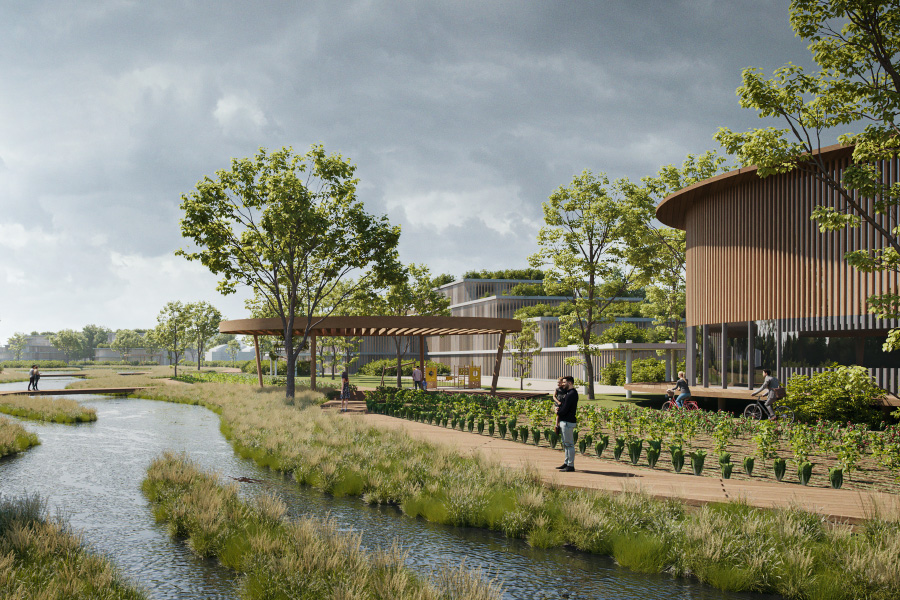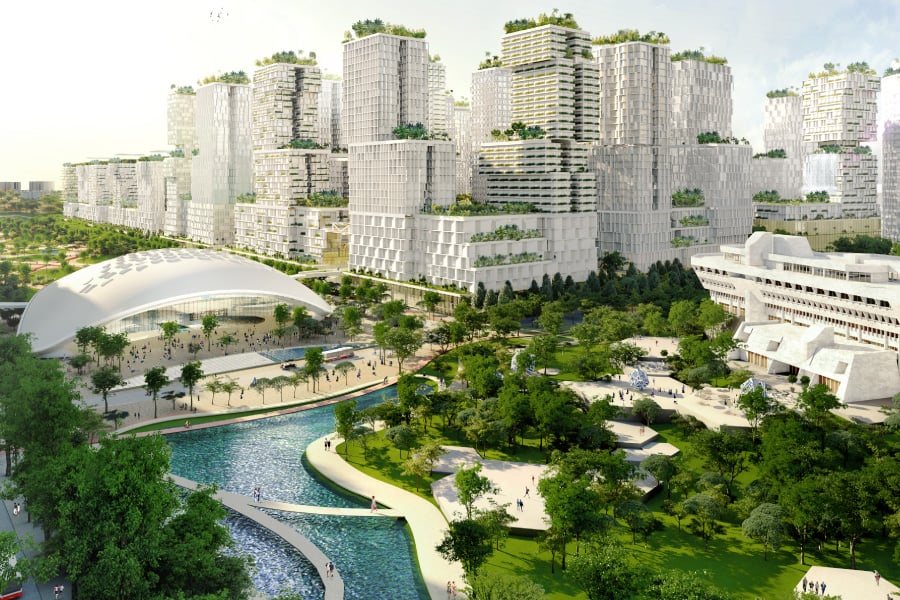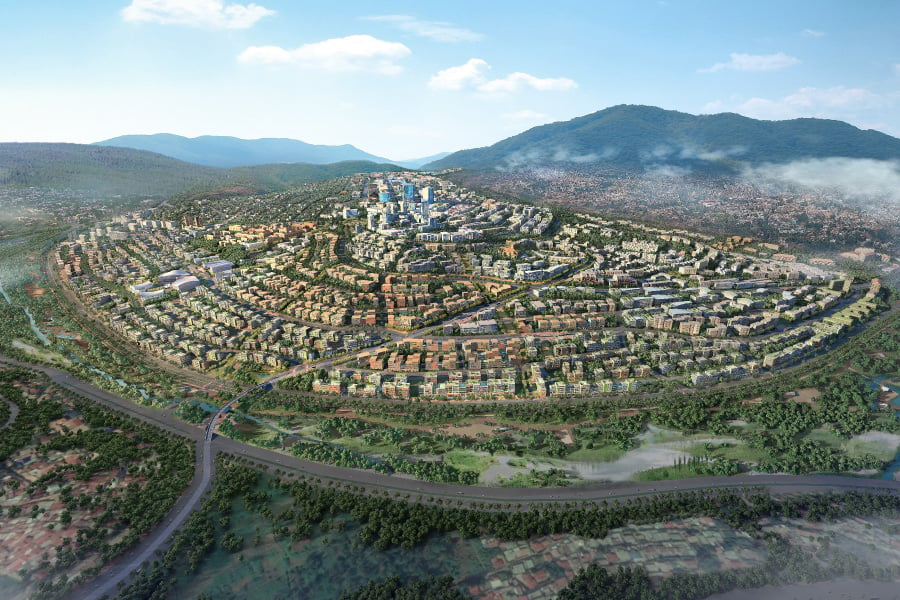December 2024
It was April 7th, 2020. The usual hustle and bustle of the morning rush hour was strangely absent. As the train pulled into Raffles Place MRT station, a sea of empty seats stared back – a stark contrast to the typical morning madness. That day marked the initiation of Singapore’s circuit breaker measures, a defining moment in our city’s response to the global COVID-19 pandemic.
Four years have passed since then, and the world has largely transitioned from crisis mode to a state of cautious optimism.
Cities, with their high population densities, were hardest hit at the time. But the pandemic presented an opportunity for designers and planners to rethink the way cities should be designed. Today, while some lingering effects of the pandemic persist, cities are now adapting and rebuilding with a renewed focus on resilience. The high-density urban environments that were once particularly vulnerable are undergoing a transformation, driven by the need to be better prepared for future challenges. Addressing social inequalities, a stark reality exposed by the pandemic, has also become a top priority for urban planners.
Singapore’s Jurong Lake District (JLD) Masterplan exemplifies this forward-thinking approach. Developed in collaboration with a multi-disciplinary team of consultants and the Urban Redevelopment Authority of Singapore, the plan serves as a model for cities seeking to decentralise their central business districts and create more equitable and resilient urban spaces.
While the JLD planning was done prior to COVID-19, there was already a foresight to ensure resilience against a Volatile, Unpredictable, Complex, Ambiguous (VUCA) future. To be able to handle the increasingly dynamic world, the masterplan is multi-layered and sophisticated, but it hinges on the following five principles:
1. Start with the Right Mix - Singapore’s Largest Mixed-use Business District Outside the City Centre
JLD is one of three main regional centres in Singapore’s plan to evolve from a concentric urbanisation model to polycentric constellation. It is intended to re-distribute living and working more evenly, reduce commuting and create a more liveable mixed-use urban environment. As Singapore’s next largest business district, JLD it will also capitalise on the ready catchment of more than 1 million residents in the West.
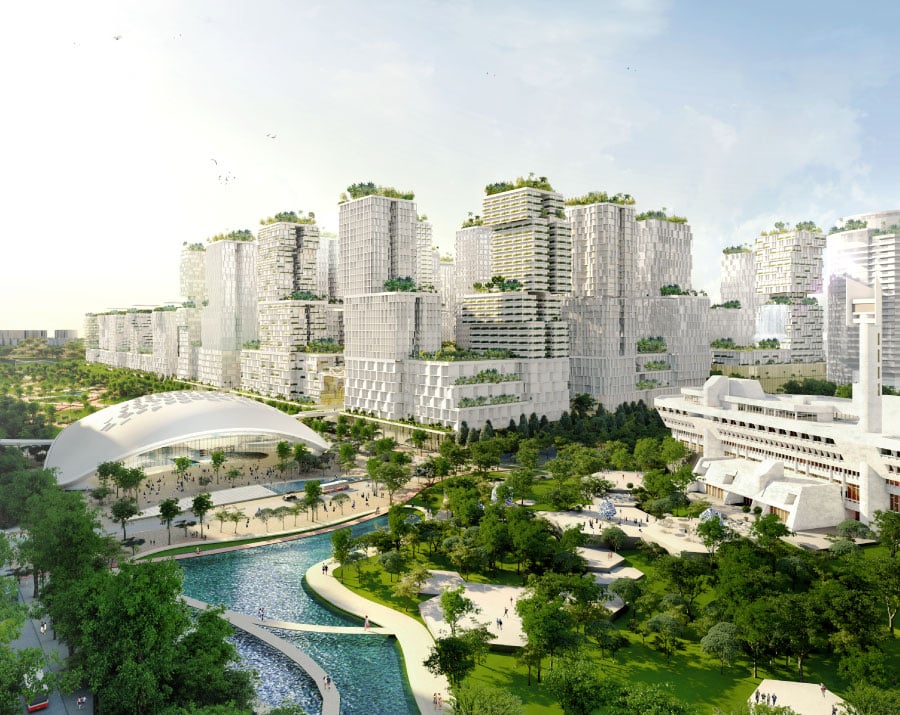
Image Source: SAA / KCAP
The realisation of the existing Central Business District (CBD) only being “alive” from 9am until 7pm illustrates the underutilisation of valuable land, stresses the city’s transport infrastructure and runs contrary to the city’s value of being sustainable. This was what led URA to introduce the CBD Incentive scheme back in 2019, to reposition the CBD as a 24/7 mixed-use district. This scheme encourages the conversion of existing and older, office developments into mixed-use developments by affording them a 25 – 30% increase in plot ratio, potentially injecting over 3,000 new homes and over 3,000 hotel rooms into the heart of the central CBD (The Business Times, 2019).
Comparatively, at the onset, JLD will accommodate a good mix of residential, offices and amenities. This planning differs vastly from the central CBD which was initially created mostly for offices. Businesses in JLD may tap on the large talent pool from the many tertiary institutions and research hubs in the vicinity, such as NTU, NUS, one-north and the Science Parks. When fully developed, JLD is envisioned to provide up to 100,000 new jobs and 20,000 new homes.
2. Embrace the Unpredictable - Flexible Future-proof Land-use
The COVID-19 pandemic forced companies to adopt widespread telecommuting which in turn spurred a significant shift in corporate planning. Businesses are now more open to permanent remote work options, leading to a reassessment of office space needs. Notably, the average office square footage per person fell 22% in 2023 (CBRE, 2023), underscoring the trend of businesses leaning toward smaller office footprints and buildings that cater to a more dispersed workforce.
As the global situation and user demands evolve, a mixed-use land planning approach such as that in JLD thus allows for maximum diversity, potential and adaptability. This requires ongoing supervision and engaged decision making to ensure the high-quality long-term development of the district.
The plots within JLD are largely zoned as white sites with the flexibility to change programme percentages according to the evolution of the site and developmental needs. Likewise, the urban morphology allows for freedom of programme occupation within the urban massing provision. In particular, the urban design guidelines which determines tower composition and porosity responds to a global trend that is shifting from large, generic office buildings to smaller, boutique and bespoke towers. Flexible and adaptable floor plates are suitable for hotels, residential and offices; theoretically, and depending on the market, towers could adapt from one programme to another. Such planning thus affords developers greater flexibility to experiment with new development concepts and typologies, and innovative ways to integrate live, work and play.
3. Instill Belonging and Ownership - Mixed-use Neighborhoods and a Sense of Identity
During the pandemic, many communities were faced with restrictions of commuting beyond their neighbourhoods. Negative consequences may however be minimised if neighbourhoods are planned to be mixed-use and where amenities, green spaces and public transport nodes will be within a 10-minute reach by walking, cycling and public transport.
Apart from being a key containment strategy under such dire circumstances, mixed-use planning in JLD promotes sustainability by reducing the need to commute.
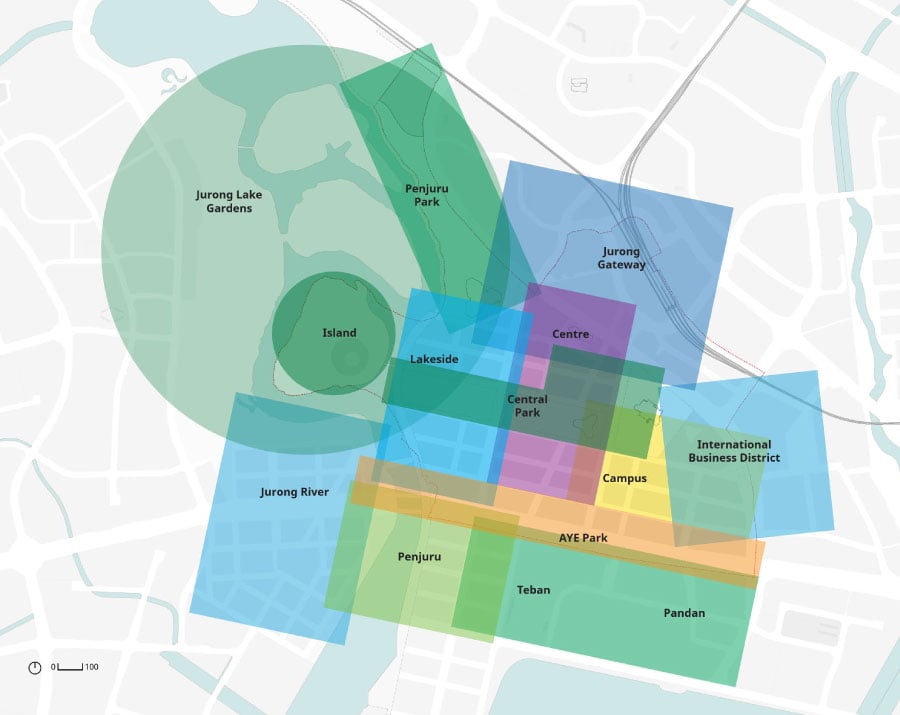
Image Source: SAA / KCAP
All in all, distinct and compact neighborhoods promote land-use synergy where residents can easily access amenities, while businesses benefit from a built-in customer base. Moreover, this instills a stronger “sense of place” and builds community identity, as evidenced by the importance of strong local community networks during the pandemic.
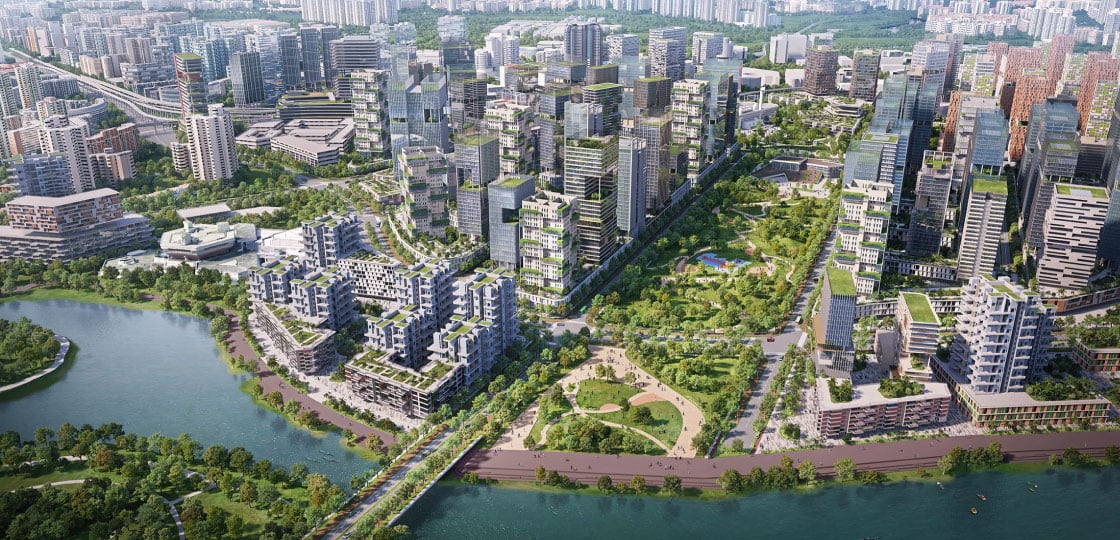
Image Source: Urban Redevelopment Authority
4. Use Nature to Enliven Places - Integrated Blue and Green Spaces
Neighbourhood parks and coastal beaches are one of the few places that experienced an increased visitorship as many found nature a welcome respite amidst COVID-19 lockdowns. Those who have convenient access to such spaces might therefore count themselves as the lucky minority.
JLD prioritises this very need to be close to nature. The Green and Blue Network respects and enhances existing natural features, forming the main structural framework for a natural integration of JLD with its context. Capitalising on its distinctive lakeside setting, the Green Loop connects green spaces, forming part of an extensive park connector network that stitches JLD together with neighbouring residential areas and links them to Jurong Lake Gardens. The district boasts an impressive future of 100ha of green spaces, 70ha of water body and 17km of waterfront areas for community activities, as well as spaces for recreation, retail and F&B. The next global crisis might not be a pandemic, but one related to climate change or an unpredictable crisis . In such scenarios, large open spaces within the dense urban fabric have proven valuable in the implementation of emergency services and evacuation protocols, as exemplified by the field hospital set up in New York’s Central Park (AFP, 2020).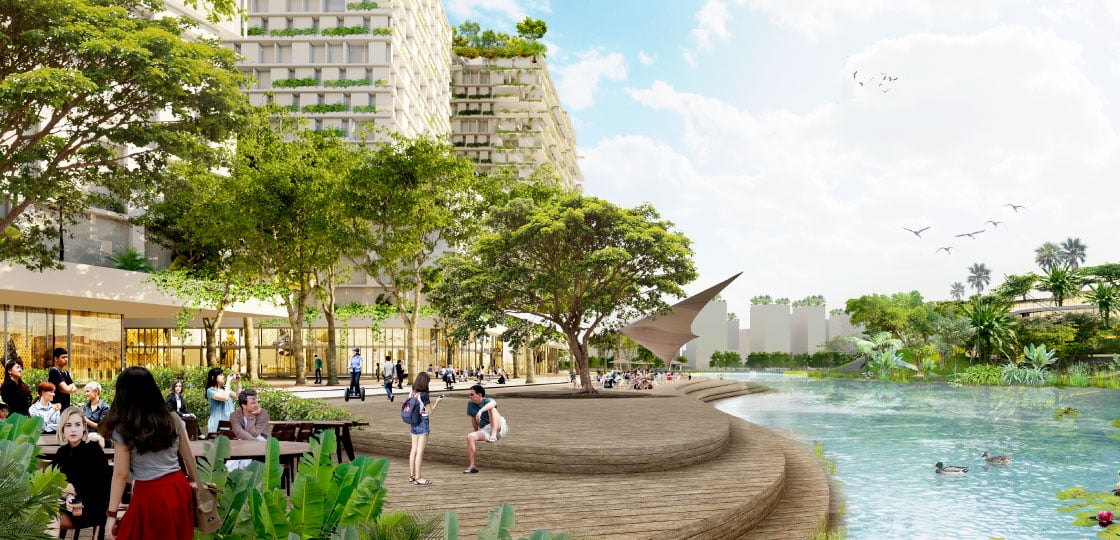
Image Source: SAA / KCAP
5. Keep People Healthy and Connected - Active Mobility Network
COVID-19 spurred a global shift towards alternative transportation, particularly cycling. Cycling networks and bike sharing services across the world witnessed a surge in traffic and demand since public transit operations may have been suspended or avoided due to health concerns and the need for social distancing. This led to a trend of several cities accelerating their plans to expand cycling infrastructure. One such example is that of the city of Bogota which created 84 kilometers of cycle lanes within a few months during the pandemic, of which 34 km became permanent lanes and were absorbed into the cycling network (ITDP, 2022).
Similarly, in JLD, the active mobility network is prioritised in the masterplan. This translates into a highly-connected continuous network of pedestrian friendly streetscapes as well as extensive dedicated paths for cycling and PMD mobility. These pathways connect to the Round Island Route (RIR) and to the local Park Connector Network (PCN). Streets are also designed with a reduced number of road lanes, thus freeing up more space for Walk Cycle Ride (WCR) modes and making it easier for people to cross the street. Key roads are also designated as Transit Priority Corridors, with bus-only usage lanes, wider footpaths and cycling paths.
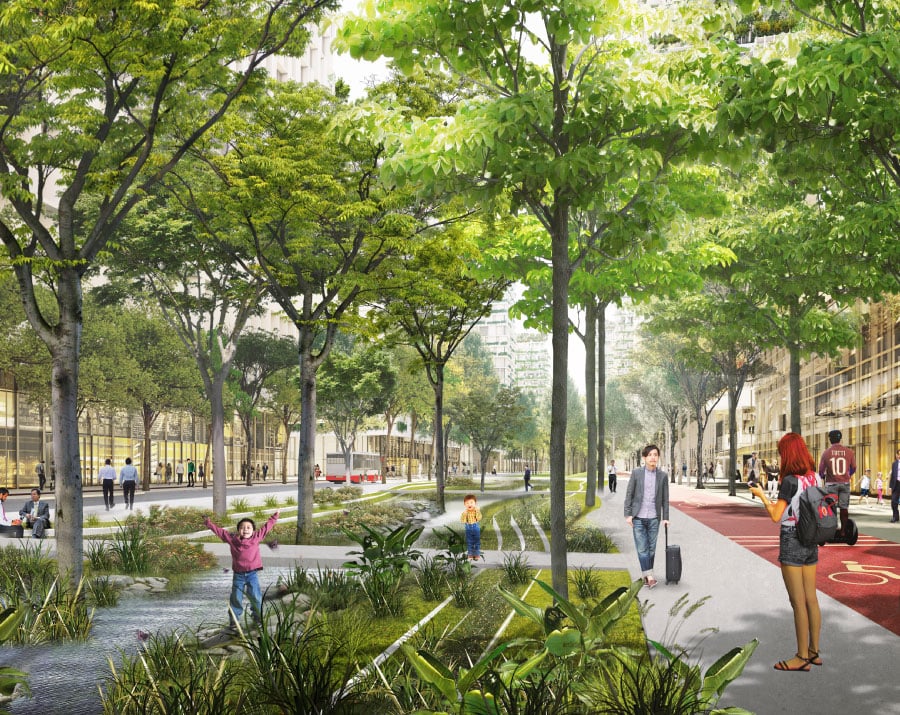
Image Source: SAA / KCAP
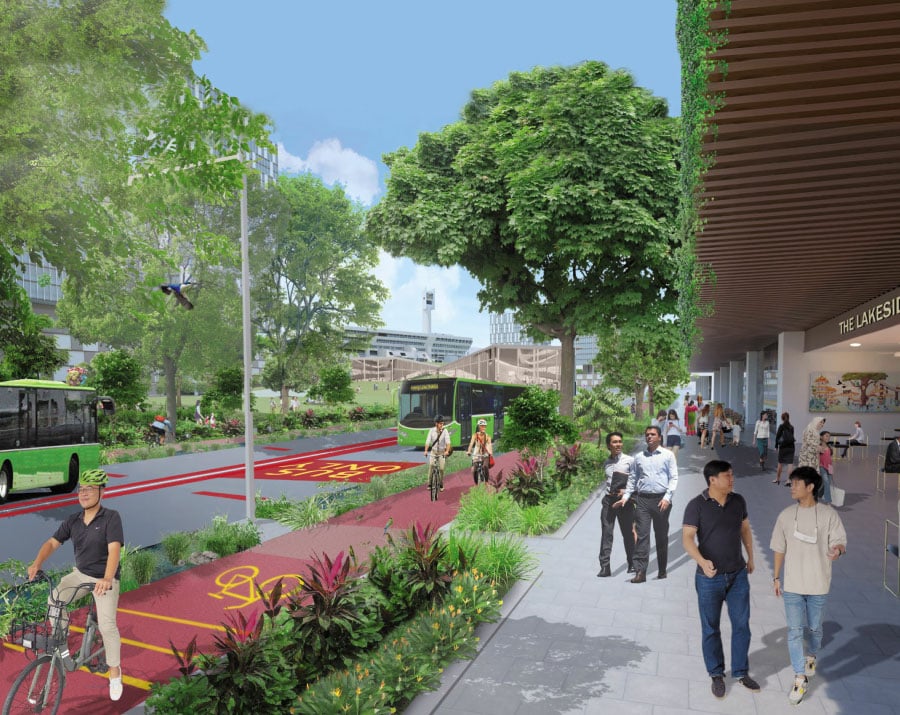
Image Source: Urban Redevelopment Authority
Additionally, JLD is characterised by an urban spine that serves to connect two intermodal hubs (Jurong East MRT in the north and the upcoming Jurong Lake District station of the Cross Island Line in the south). This critical link is achieved through the elevated J-Walk. The J-Walk offers a comfortable and barrier-free pedestrian route between the two MRT stations that are located 700 metres apart, with seating provided at intervals for restful breaks for users of all ages and abilities.
During a pandemic outbreak where everyone is encouraged to stay within their neighborhoods, residents may opt for a well-sheltered leisure route to access the diverse amenities in their mixed-use district. JLD’s provision of adequate public space and leisure routes are thus a means for residents to cope with the cessation of hustle and bustle, empowering residents to maintain a healthy and balanced lifestyle.
Unfolding Potential
In June 2023, URA launched a 6.5ha white site for sale to a Master Developer (URA, 2023) which comprises three adjacent plots of land that will be developed in multiple phases, and will provide the critical mass to propel JLD. By 2028, we may also expect the completion of a new Jurong Region Line station and an Integrated Transport Hub next to Jurong East MRT station comprising offices, community spaces and retail amenities. With groundbreaking developments on the horizon, Jurong Lake District is surely poised to become a magnet for innovation, investment, and community.
Bibliography
AFP. (2020, March 20). Field hospital set up in New York’s Central Park amid influx of coronavirus patients. Retrieved from The Straits Times:
https://www.straitstimes.com/world/united-states/field-hospital-set-up-in-new-yorks-central-park-amid-influx-of-coronavirus
CBRE. (2023, December 12). 2023–2024 CBRE Global Workplace & Occupancy Insights. Retrieved from CBRE:
https://www.cbre.com/insights/books/2023-2024-cbre-global-workplace-and-occupancy-insights/conclusion
ITDP. (2022). From Transmilenio to Cycle Networks – Lessons Learned from Bogotá’s Comprehensive Urban Mobility Planning. New York: Institute for Transportation & Development Policy.
The Business Times. (2019, April 12). Rejuvenating CBD with new integrated buildings ‘visionary’: JLL. Retrieved from The Business Times:
https://www.businesstimes.com.sg/property/rejuvenating-cbd-new-integrated-buildings-visionary-jll
URA. (2019, March 27). REJUVENATION INCENTIVES FOR STRATEGIC AREAS: Central Business District (CBD) Incentive Scheme. Retrieved from URA:
https://www.ura.gov.sg/Corporate/Guidelines/Circulars/dc19-04
URA. (2023, June 22). URA launches tender for a Master Developer site at Jurong Lake District to propel the development of Singapore’s largest business district outside the CBD. Retrieved from URA:
https://www.ura.gov.sg/Corporate/Media-Room/Media-Releases/pr23-19




